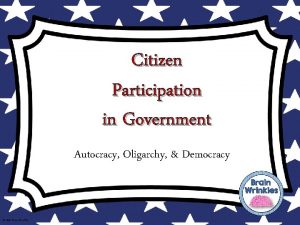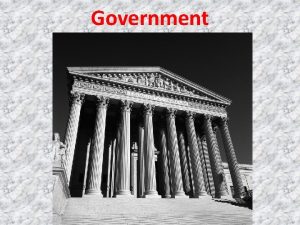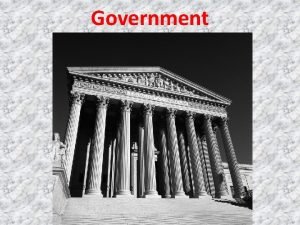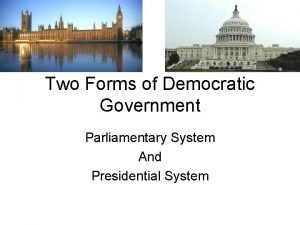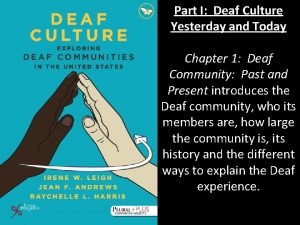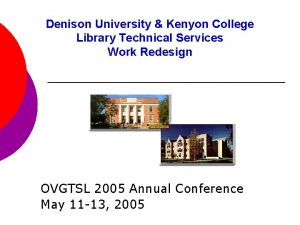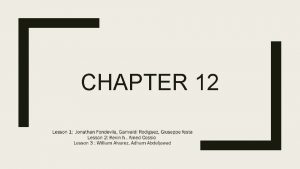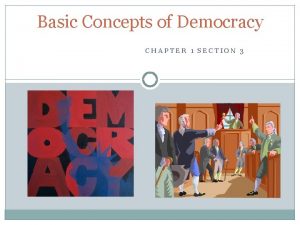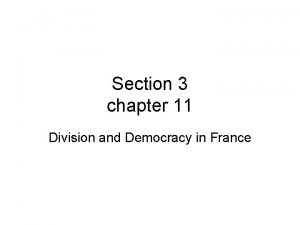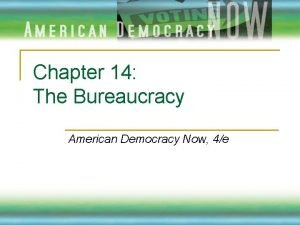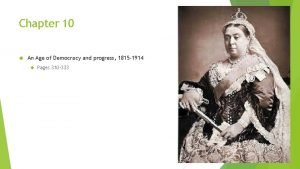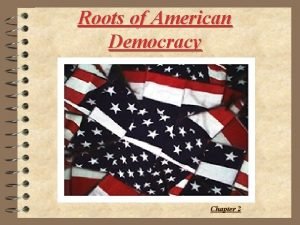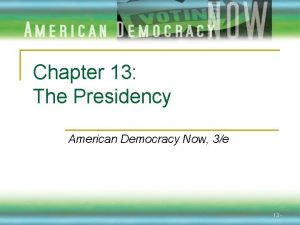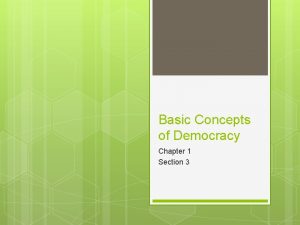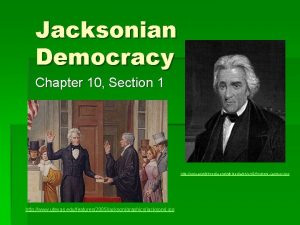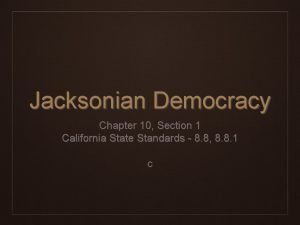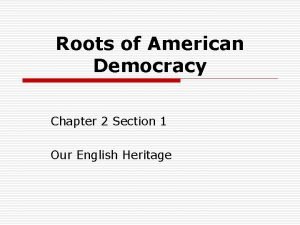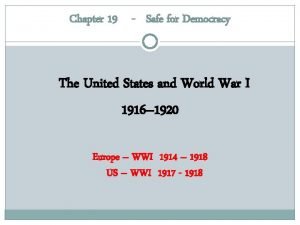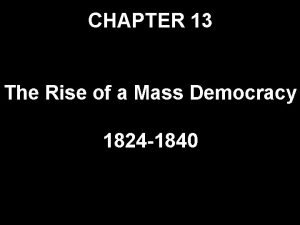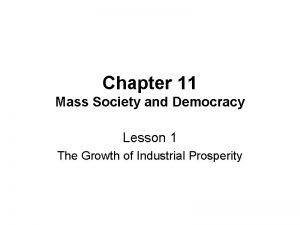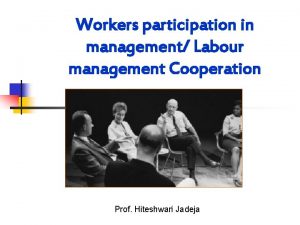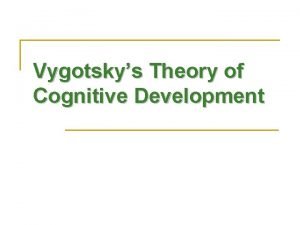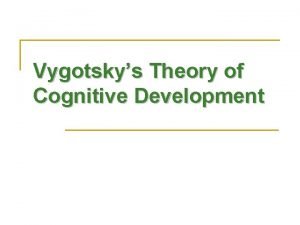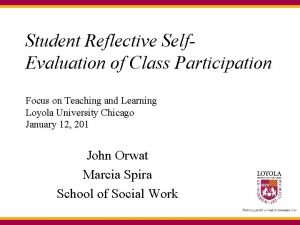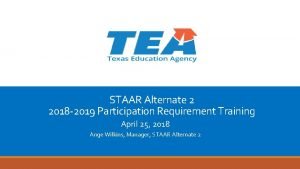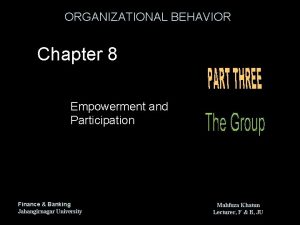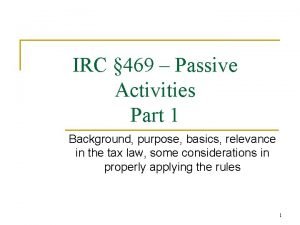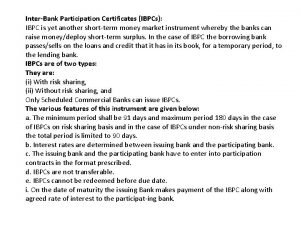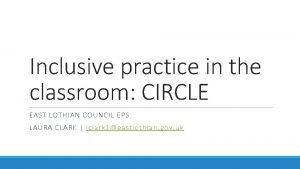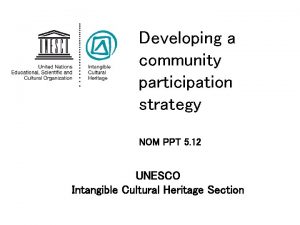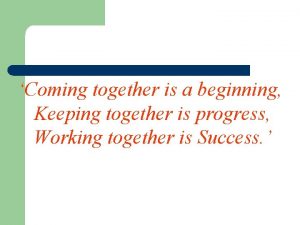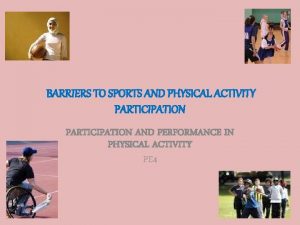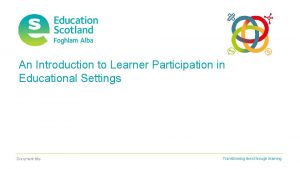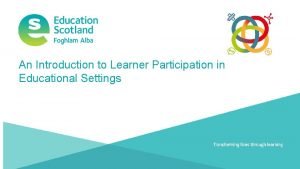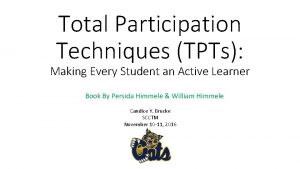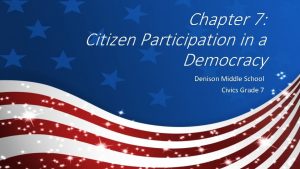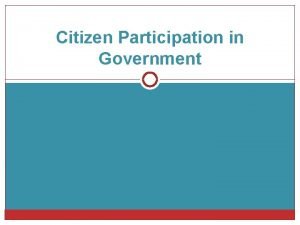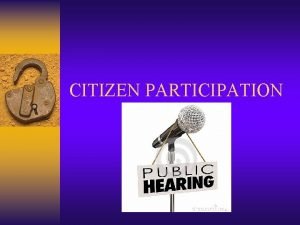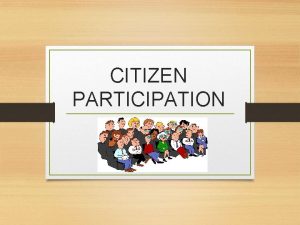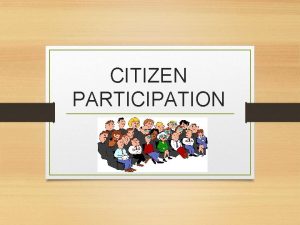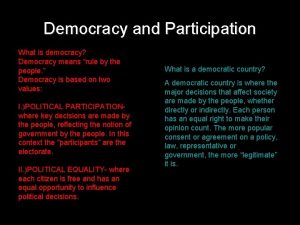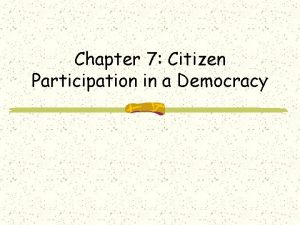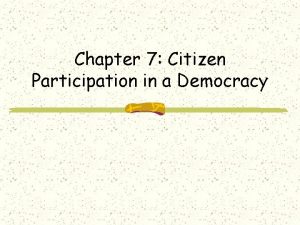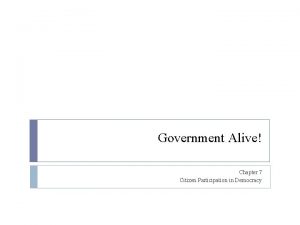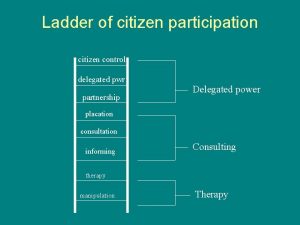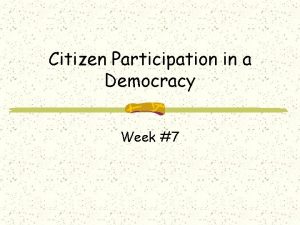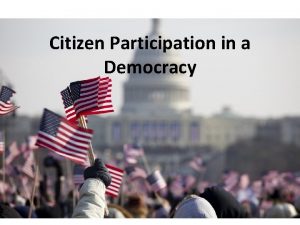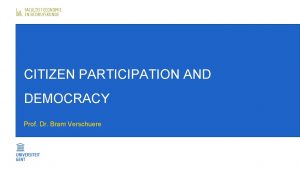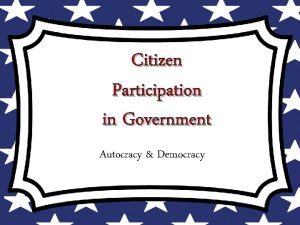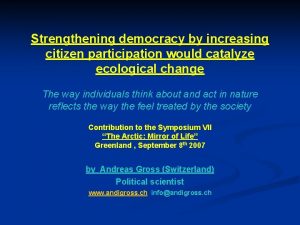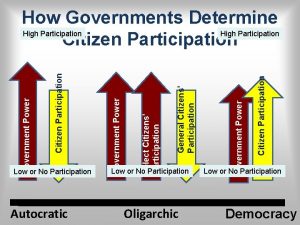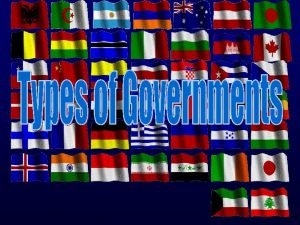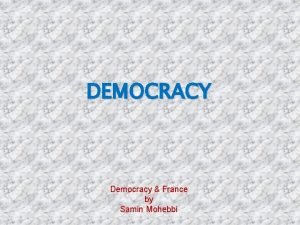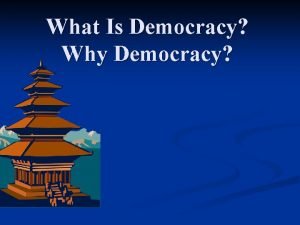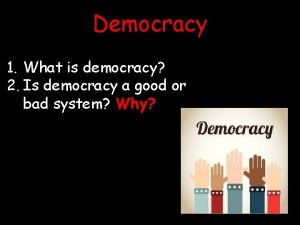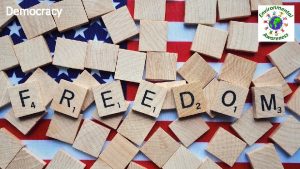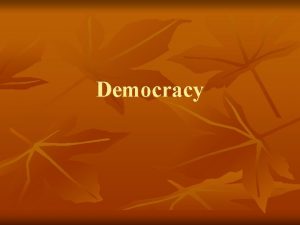Chapter 7 Citizen Participation in a Democracy Denison











































- Slides: 43

Chapter 7: Citizen Participation in a Democracy Denison Middle School Civics Grade 7

Chapter 7 Florida Standards SS. 7. C. 2. 1 Define the term “citizen, ” and identify legal means of becoming a United States citizen. SS. 7. C. 2. 2 Evaluate the obligations citizens have to obey laws, pay taxes, defend the nation, and serve on juries. SS. 7. C. 2. 3 Experience the responsibilities of citizens at the local, state, and federal level. SS. 7. C. 2. 14 Conduct a service project to further the public good. SS. 7. C. 3. 7 Analyze the impact of the 13 th, 14 th, 15 th, 19 th, 24 th, and 26 th amendments on participation of minority groups in the American political process.

Preview • Analyze the following photograph of a lunch counter sit-in. • Then answer these questions : • 1. What interesting details do you see? • 2. What actions do these people appear to be taking? • 3. What problem or problems do you think these people are trying to address? • 4. What do you think the results of their actions were?

Preview • In the 1960 s, many major retailers in the South had segregated lunch counters. In protest, people organized sit-ins to force the companies to change their policies. • In this photograph, college students hold a sit-in at a Walgreens lunch counter. • Sometimes protesters were taunted and even attacked by onlookers. Walgreens, and other retailers, chose to close their lunch counters rather than to serve the students.

Preview • John R. Salter (also known as Hunter Bear), a prominent civil rights activist and a university professor in Mississippi, described a Woolworths lunch counter sitin, in which he participated in Jackson, Mississippi, as “the most violently attacked sit-in during the 1960 s. . . A huge mob gathered, with open police support while three of us sat there for three hours. I was attacked with fists, brass knuckles and the broken portions of glass sugar containers, and was burned with cigarettes. ” • As a result of the sit-ins, cafes and lunch counters eventually ended their segregation policies.

Section 7. 1: Introduction Pages 123 - 124

• You have just seen one example of a form of civic participation that helped draw attention to a societal problem in the 1960 s: the lack of civil rights for African American citizens. • In this lesson, you will learn more about the process of becoming a U. S. citizen and closely examine the rights and responsibilities of citizenship. • You will look at how Americans have effectively used civic participation to address problems facing their communities, their country, and the world.

• Throughout this lesson, you will examine such important questions as: • • What does it take to become a citizen of the United States? • • What does it mean to be a citizen? • • How can ordinary people make a difference in a democratic society like the United States?

• Read Section 1, Introduction, in the Student Text (Page 123). • Then respond to these questions: • • What does Robert D. Putnam say about how the participation of Americans in civic, social, and religious groups has changed over the past century and a half? • • Do you think this change in behavior is cause for concern? Why or why not?

Section 7. 2: Citizenship, Civic Rights, and Civic Responsibilities Pages 124 - 127

Citizenship, Civic Rights, and Civic Responsibilities • The U. S. Constitution, as originally written, did not define citizenship. • When the U. S. Constitution was adopted, it was generally assumed that state citizens would become U. S. citizens. • It was also assumed that a person born in the United States was a citizen. • In 1857, the Supreme Court shook up these assumptions in its ruling for the case Dred Scott v. Sandford. • The Court held that Dredd Scott, an enslaved African American born in Virginia, was not a citizen and therefore could not sue for his freedom in federal court. If he was not a citizen… what was he then?

The Fourteenth Amendment Defines Citizenship • The 14 th Amendment was adopted to address the issue of citizenship and reverse the Dredd Scott decision. • Ratified in 1868, the Amendment clarified who was a citizen under the Constitution, stating that all persons born on American soil are to be considered U. S. citizens no matter where their parents were born. • The purpose of the 14 th Amendment was to extend the rights of citizenship to former slaves. citizenship – the status of being a citizen, a person who by birth or naturalization enjoys certain rights and has certain duties in a nation-state.

African Americans’ Long Struggle for Civil Rights • The 14 th Amendment’s immediate effects were limited. • In the late 1800 s, southern states passed laws, known as Jim Crow laws, that enforced segregation and denied equality to blacks. • It took many decades for the courts and Congress to overturn those laws.

African Americans’ Long Struggle for Civil Rights • Timeline, pages 124 - 125

African Americans’ Long Struggle for Civil Rights • An early setback in the struggle for equal rights occurred when the Supreme Court heard Plessy v. Ferguson in 1896 • Homer Plessy was a black man who was arrested in Louisiana for sitting in a whites-only railroad car. Plessy argued the legality of his arrest by stating that the Jim Crow laws that segregated blacks from whites violated the Equal Protection Clause of the 14 th Amendment. • The Court ruled against Plessy stating that separate facilities for blacks and whites were legal as long as they were equal. • This “separate but equal” doctrine was soon applied to almost every aspect of life in southern states.

African Americans’ Long Struggle for Civil Rights • Despite this decision, African Americans continued to fight for equal rights. • They formed organizations such as the National Association for the Advancement of Colored People (NAACP), the National Urban League, and the Congress of Racial Equality (CORE) to protest racial discrimination in its many forms.

African Americans’ Long Struggle for Civil Rights • In 1954, the NAACP won the Brown v. Board of Education of Topeka • The case focused on the rights of a young African American, Linda Brown, who was prohibited from attending a white school near her home in Topeka, Kansas. • This time the Supreme Court ruled that “separate but equal” facilities were by their very nature unequal. • This ruling paved the way for desegregation of public schools and launched the modern civil rights movement.

African Americans’ Long Struggle for Civil Rights • During the 1950 s and ‘ 60 s, the civil rights movement touched all aspects of American life. • The most prominent leader was Martin Luther King Jr. , who helped make Americans aware of the great injustices imposed on people of color.

African Americans’ Long Struggle for Civil Rights • On July, 2, 1964, President Lyndon B. Johnson signed the Civil Rights Act of 1964 into law. • This landmark legislation banned discrimination in most areas of American life on the basis of race, sex, religion, or national origin. • It also committed the U. S. government to protecting the rights of all Americans, regardless of skin color or country of birth.

Rights and Responsibilities • The Civil Rights Act of 1964 increased immigration both legal and illegal. • Once in this country, most lawful permanent residents enjoy the same rights as native-born Americans, including the rights listed in the Bill of Rights, the right to vote, the right to hold public office, and the right to claim social and economic benefits (civic rights) • lawful permanent resident – an immigrant who is legally authorized to live and work in the United States permanently, but is not a U. S. citizen. Also known as a resident alien or legal resident.

Rights and Responsibilities • All people living in the United States have certain legal responsibilities. • They are required to obey laws, pay taxes, and cooperate with public officials. • All males who are 18 and, whether citizens, lawful permanent residents or undocumented immigrants, must register for military service. • Citizens have an added responsibility to be informed and participate in public affairs (civic responsibilities) undocumented immigrant – a person who has come to the United States to live and work without the required legal papers.

Section 7. 3: Becoming an American Citizen Pages 127 - 129

American Citizens: Native Born and Naturalized • By 2003, more than 33 million Americans, or about 12% of the U. S. population, were foreign born. • There are two ways to become a U. S. citizen: 1. by birth (most common) 2. by naturalization • Naturalization - is a multistep legal process that, when completed, gives the applicant virtually all the rights and responsibilities of a native-born citizen. • In 2005, more than 600, 000 people became citizens through naturalization.

American Citizens: Native Born and Naturalized • Immigrants must meet several requirements for naturalization, including being 18 years of age and a lawful permanent resident of the United States, living in the United States for at least 5 years. • After completing those requirements, the next step is to complete an application for naturalization. • If the application is approved, the applicant must have an interview with an immigration official who will then test the applicant’s ability to speak, read, and write English, as well as the applicant’s civics knowledge of American history and government. • The final step in the naturalization process is the citizenship ceremony. • Naturalization gives new citizens the right to vote and run for public office except that of vice president or president.

Page 128

The Status of Lawful Permanent Residents • Immigrants don’t need to become citizens to stay in the United States legally as they may remain as lawful permanent residents indefinitely. • In 2005, the United States granted permanent resident status to over one million people. • Immigrants seeking permanent resident status must go through an application process with the Bureau of Citizenship and Immigration Services. • Preference for residency is given to applicants that possess job skills needed in the United States and/or have family that are citizens. • Those who successfully complete the application process receive a green card (i. e. : proof that its holder is a legal resident and has a legal right to live and work in the United States).

The Status of Lawful Permanent Residents • Resident aliens (lawful permanent residents) enjoy most of the rights of citizens. • These rights include the right to travel freely outside the country. • If the resident is out of the country for over a year, they must apply for a reentry permit. • Resident aliens may lose their permanent resident status and be deported if they are convicted of a crime.

Section 7. 4: Political Culture in the United States Pages 129 - 133

Political Culture in the United States • Citizens and residents of the United States operate within a political culture. • Political Culture - is a society’s framework of shared values, beliefs and attitudes concerning politics and government. • It is the political environment in which Americans exercise their rights and responsibilities. • Political culture can take many forms and be expressed in many ways • E. g. : The strong surge of patriotism after the 9/11 terrorist attacks in 2001.

Americans’ Shared Political Values • Although Americans often disagree on specific issues, they share a number of core beliefs and values. • The beliefs listed below shape our political culture: 1. 2. 3. 4. 5. 6. Liberty- Openly express their views without punishment from the government Equality- Equality of opportunity without regard to race, religion, or gender Democracy- The belief that political authority comes from the people Individualism- Belief of personal freedom and responsibility Free Enterprise- Support of capitalism and a free-market economy Justice and the rule of law- Society governed by a system of laws that are fairly and equally applied 7. Patriotism- Pride and loyalty towards one’s country 8. Optimism- Being upbeat attitude 9. Civic duty- Citizens should vote and participate in civic and political affairs

Two Widely Held Ideologies: Liberalism and Conservatism • Although Americans share a common political culture, they do not all hold to the same ideology (i. e. : basic political beliefs). • Americans often disagree on such things as the role government should play with respect to economic and moral values. Most people identify their political ideology as being liberal or conservative.

Two Widely Held Ideologies: Liberalism and Conservatism • Liberalism is an ideology that favors an active role for the government in solving society’s problems. • Liberals generally support: • • Governments efforts to regulate business and the economy Policies designed to reduce economic inequality Providing assistance to the poor Government regulations to protect the environment and improve the healthcare system • Liberals strongly defend liberty and resist governments efforts to interfere in people’s personal lives.

Two Widely Held Ideologies: Liberalism and Conservatism • Conservatism is an ideology that calls for a limited role for government in economic affairs. • Conservatives generally oppose government regulation of business • Most conservatives want to: • Limit the size of government • Reduce taxes • Cut back on government programs • Compared to liberals, conservatives support government action on moral issues. E. g. : gay marriage and abortion

Two Widely Held Ideologies: Liberalism and Conservatism • Over the past few decades, more Americans have identified themselves as conservatives than as liberals. • Since the 1960 s, the percentage of Americans self-identifying themselves as conservatives has varied between 30% and 40%. • Liberals remained constant around 20%.

Three Other Ideologies: Socialism, Libertarianism, and Environmentalism • The main goal of socialism is to limit economic inequality by ensuring a fair distribution of wealth. • In a socialist system, the government owns or controls most of the economic resources needed for the production of goods and services. • Socialism never became as popular in the United States as it did in other countries, in part because it conflicted with America’s political culture. • Most American socialists today support what is known as democratic socialism • i. e. : This is an ideology that advocates socialism as a basis for the economy and democracy as a governing principle.

Three Other Ideologies: Socialism, Libertarianism, and Environmentalism • Modern libertarianism is an ideology based on a strong belief in personal freedom. • Libertarians tend to be conservative on economic issues and liberal on social issues. • E. g. : They favor lower taxes and a free-market economy, while opposing bans on abortion and gay marriage. • Libertarians want a small government and resist government regulation of any kind.

Three Other Ideologies: Socialism, Libertarianism, and Environmentalism • Environmentalism unites Americans who are deeply concerned about the conservation and protection of the environment. • Environmentalists advocate policies designed to reduce pollution and preserve natural resources. • In contrast to libertarians, environmentalists support government regulation of industry and the economy to achieve those ends.

The Modern in the Middle: Centrism • Most Americans fit neatly into any ideological camp. • These people consider themselves moderates, or middle-of-the-road voters. • Centralists typically hold a mix of liberal and conservative views. • At election time, these voters often cross party lines, depending on the candidates and the issues of the day.

Section 7. 5: How Americans Engage in Civic Life Pages 133 - 137

How Americans Engage in Civic Life • There are many ways to become an active citizen engaged in civic life including voting, reading or watching the news to stay informed, talking to friends about political issues, volunteering in the community or writing a letter to a public official.

Civic Society: The “Social Capital” of Democracy • Some argue that social clubs and civic organizations are the building blocks of what political scientists call civil society, society (i. e. : the voluntary associations and institutions that exist between government and individuals). • Citizen involvement helps expand a society’s social capital (i. e. : the “connections among individuals” that are forged through their participation in voluntary associations). • E. g. : participation in a school’s PTA creates a social network that leads to an exchange of information about participant’s community. (Parents improving their children’s schools)

Four Categories of Civic Engagement: Which One fits you? • How engaged are most Americans? • Electoral specialists - Main engagement is through the election process. E. g. : voting. • Civic specialists - People in this group are focused on improving their community and helping others. E. g. : joining a local civic group. • Dual activists - This category is made up of people who are engaged both in the electoral and civic activities. • The disengaged - Made up of people who are not significantly engaged in civic affairs. They do not vote or pay attention to civic affairs.

Page 136
 Chapter 7 citizen participation in a democracy answers
Chapter 7 citizen participation in a democracy answers Total participation and partial participation
Total participation and partial participation Oligarchy citizen participation
Oligarchy citizen participation Presidential democracy definition
Presidential democracy definition Examples of oligarchy
Examples of oligarchy Citizen participation in autocracy
Citizen participation in autocracy Parliamentary government
Parliamentary government Values of deaf culture
Values of deaf culture The denison organizational culture survey
The denison organizational culture survey Shelby denison
Shelby denison Denison university library
Denison university library Chapter 13 the rise of a mass democracy
Chapter 13 the rise of a mass democracy Chapter 12 lesson 1 jacksonian democracy
Chapter 12 lesson 1 jacksonian democracy Basic concepts of democracy
Basic concepts of democracy Dryfus affair
Dryfus affair American democracy now chapter 14
American democracy now chapter 14 Chapter 10 an age of democracy and progress answer key
Chapter 10 an age of democracy and progress answer key Chapter 2 roots of american democracy answers
Chapter 2 roots of american democracy answers Chapter 13 the presidency
Chapter 13 the presidency Chapter 1 section 3 basic concepts of democracy
Chapter 1 section 3 basic concepts of democracy Chapter 10 section 1 jacksonian democracy
Chapter 10 section 1 jacksonian democracy Chapter 10 section 1 jacksonian democracy
Chapter 10 section 1 jacksonian democracy Chapter 2 roots of american democracy answers
Chapter 2 roots of american democracy answers World's constable cartoon
World's constable cartoon Chapter 13 the rise of a mass democracy
Chapter 13 the rise of a mass democracy Mass society and democracy lesson 1
Mass society and democracy lesson 1 Joint management council
Joint management council Guided participation vygotsky
Guided participation vygotsky Guided participation vygotsky examples
Guided participation vygotsky examples Class participation self-evaluation essay
Class participation self-evaluation essay Staar alt 2 participation requirements examples
Staar alt 2 participation requirements examples Empowerment and participation in organizational behavior
Empowerment and participation in organizational behavior Section 469 material participation
Section 469 material participation Inter bank participation certificate ppt
Inter bank participation certificate ppt Circle inclusive classroom scale
Circle inclusive classroom scale Community participation ppt
Community participation ppt Participation constraints in dbms
Participation constraints in dbms Active community participation definition
Active community participation definition Workers participation in management
Workers participation in management Sports
Sports Learner participation in educational settings
Learner participation in educational settings Learner participation in educational settings
Learner participation in educational settings Total participation techniques book
Total participation techniques book Sisters participation in the gathering of israel
Sisters participation in the gathering of israel


